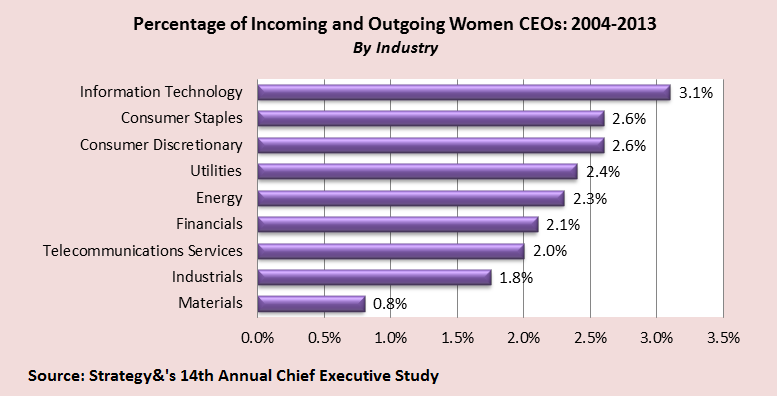 The number of women becoming CEOs of the world’s largest public companies has gained slightly over the previous decade. But their percentage remains stubbornly low in sectors such as finance and other industries, according to a new study.
The number of women becoming CEOs of the world’s largest public companies has gained slightly over the previous decade. But their percentage remains stubbornly low in sectors such as finance and other industries, according to a new study.
Strategy& (formerly Booz & Co.) drew this conclusion as part of its 14th annual Chief Executive Study, which looked at CEO turnover and data involving incoming and outgoing CEOs at 2,500 of the world’s largest companies from 2004 through 2013.
They found that women CEOs remain rare—in the low single digits—but they expect women to make up about a third of new CEO appointments by 2014, based on hiring trends they observed.
That’s all well and good, though the data showed there is plenty of room for improvement at present, particularly in the financial sector. The researchers determined that the percentage of incoming and outgoing women CEOs from 2004-2013 reached just 2.1 percent in the financial industry, with information technology, consumer staples, consumer discretionary, utilities and energy all scoring higher.
Only the telecommunications, industrials and materials industries scored lower, according to the report.
Overall, the study found that the total share of women becoming CEOs of the world’s biggest companies reached 3.6 percent over the past five years, compared to 2.1 percent over the previous five-year period. However, women were just 3 percent of 2013’s new crop of mega-company CEOs, itself a 1.3 percent drop versus 2012, Strategy& concluded.
Other findings in the report:
• Female CEOs are often hired from outside the company, with boards most often picking existing internal execs to be their next leaders.
About 78 percent of male CEOs between 2004 and 2013 were insiders, but 65 percent of female CEOs who rotated in or out during the same period held that status.
• Women CEOs are forced out more often than their male counterparts.
Through the previous decade, 38 percent of female CEOs in the world’s biggest companies who left their jobs were actually forced out. That only happened to 27 percent of male CEOs.
• The U.S. and Canada had the highest percentage of incoming and outgoing women CEOs over the previous 10 years, at 3.2 percent.
Western Europe landed at 1.4 percent, and China came in at 2.5 percent. Just 0.8 percent of Japanese companies’ incoming and outgoing women CEOs during that period were female.
Brazil, Russia and India’s biggest companies had a 1.7 percent rate of incoming and outgoing female CEOs during the previous decade, according to the study.






















 Underwriter, Actuary Fears of AI Drop; Work Needed on Collaboration
Underwriter, Actuary Fears of AI Drop; Work Needed on Collaboration  What to Expect in 2026: U.S. P/C Results More Like 2024
What to Expect in 2026: U.S. P/C Results More Like 2024  California Workers Comp Combined Ratio for 2024 Highest in 20-Plus Years
California Workers Comp Combined Ratio for 2024 Highest in 20-Plus Years  Slideshow: Carrier Management’s 2025 Top Editor’s Picks (Unlocked)
Slideshow: Carrier Management’s 2025 Top Editor’s Picks (Unlocked) 






